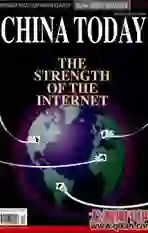Old and New Meet in a Beijing Hutong
2009-05-05BystaffreporterLIYAHONG
By staff reporter LI YAHONG

JIN Xin, the young owner of the Pass By Bar, looks calm and detached as he talks, angling his head. The Pass By was the first bar to open on Nanluoguxiang (NLGX), a hutong now packed with bars and cafés in the old part of Beijing. Since 1999, the lane has been transformed from a quiet residential area into a popular place for socializing and buying traditional Beijing cultural products.
The 800-meter long north-south hutong is just few kilometers from the rear of the Forbidden City. “A decade ago, it was like a girl who never used makeup, but now she abuses it a little bit,” comments Jin Xin.
Old Times
Established in the Yuan Dynasty (1271-1368), NLGX used to be called Luoguoxiang. In the 15th year of Emperor Qian Longs reign (1750), the name was changed to its present moniker. Today NLGX remains one of the best-preserved hutongs featuring traditional Beijing architecture – an oasis of traditional buildings in a sea of demolition and building sites.
Beijing was once riddled with thousands of “hutong,” or lanes, dissecting the old city like a maze. The Names of Beijing Streets and Alleys published in 1986 states that at that time there were 6,104 hutongs in Beijing. As modernization and economic development have quickened, the hutongs have rapidly disappeared, replaced by wide boulevards and highrises. There are now only 1,300 of the old lanes still intact.
NLGX was once home to many celebrities and officials. Sun Yat-sen, founder of the Chinese Republic, and Chiang Kai-shek, long-term head of the Kuomintang, both lived here for a time. Among the 1,000 courtyards in this area, there are several hundreds well-preserved structures featuring traditional entrance gates and screen walls. Although the archaic buildings today appear less stately than they once did, the exquisite architectural carvings still convey a sumptuous ambience. The culture and atmosphere of old Beijing lend a special flavor to the bars and cafes here.
In 1999, the Pass By Bar was situated in a 40-square-meter house. Now it has a new home in a typical Beijing siheyuan, and has opened a second branch nearby.
Like many of his customers, owner Jin Xin is a travel-crazy backpacker, and the Pass Bys décor reflects his passion. A huge goats skull is suspended from the buildings roof beam, a souvenir Jin Xin carried back from Tibet. On the wall hang straw sandals, horsewhips and a map, while the bookshelves are stacked with travel magazines. In 1998, Jin Xin was lured to Beijing by the citys attractive cultural atmos-phere. “At that time, several friends of mine hung out at different places, having drinks and talking,” recalls Jin Xin. “Travelers need a cultural place to take a rest and communicate.” The Pass By Bar was thereby established. In choosing a location, he deliberately kept away from the hustle of Beijings older bar strip in the eastern embassy zone. “I wanted a quiet place and hoped to attract different customers.”
“Walking into this lane with its grayish bricks, I feel at ease, and I like the soft and lingering music coming out of the shops and bars,” said tourist Lu Man. In the evening, the red lanterns hanging at the entrance of the Pass By Bar begin to gleam, casting soft light on the old wooden signboard, making people feel warm, comfortable and at home.

Blend of Tradition and Modernity
NLGX is a blend of tradition and modern fashion, attracting more and more merchants to sell local-style items. While many of the cafés and bars are decked out in traditional Beijing styles, many serve non-Chinese cuisine. The Pass By Bar specializes in various Western-style dishes with an emphasis on Italian cuisine. Its especially known for its milk tea and pizza. Many expats and overseas visitors come here to talk, drink coffee and enjoy the food.
Besides the Pass By Bar, about 115 domestic and overseas shops are gath-ered here, selling everything from exquisite porcelain, to notebooks wrapped in ox hide, to decorative crafts.
Situated in a small siheyuan, Art At Home sells Chinese embroidery, featuring flowers, birds, fish, insects, and sometimes female figures in an old Shanghai style.
Up the street, a young British man named Dominic Johnson Hill operates a famous T-shirt shop called “Plastered 8.” His T-shirts feature unique designs encapsulating everyday aspects of Beijing life, like old subway tickets, bus stops and street signs, as well as slogans from yesteryear such as “Weida de Maozhuxi Wansui” (“Long Live Great Chairman Mao”). Dominic Johnson Hill fell in love with Beijing when he came here 14 years ago, and decided to settle down and run Plastered 8. From his point of view, Beijing has many special and latent beautiful aspects, so he used these as inspiration when he began to design his unique T-shirts. As he remarks, “Those slogans make people feel nostalgic with warmth.”
In front of a Chinese opera mask, six Korean students dressed in hip hop apparel demonstrate their street dances. Some people find the mix of traditional Chinese siheyuan and bars a strong cultural shock.
The number of visitors to NLGX is steadily growing. Even during the December mid-winter off-season, there are still lots of tourists and locals visiting the bars and cafés. The local sub-district office estimates that during the peak season, the daily number of tourists coming here is almost 1,000.
Reading between the lines, Jin Xin seems to have some worries about NLGXs future. “The Pass By used to be a bar, but it has now become my lifestyle. Perhaps one day, we wont be able to persist because the lifestyle here totally changes.”
